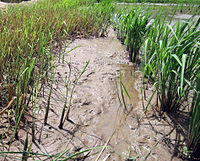
Photo from wikipedia
Compared with annual crops, perennial crops with longer growing seasons and deeper root systems can fix more sunlight energy, and have advantages in reducing soil erosion and saving water, fertilizer… Click to show full abstract
Compared with annual crops, perennial crops with longer growing seasons and deeper root systems can fix more sunlight energy, and have advantages in reducing soil erosion and saving water, fertilizer and pesticide inputs. Rice is one of the most important food crops in the world. Perennial rice can be of great significance for protecting the ecological environment and coping with the shortage of young farmers due to urbanization. Oryza longistaminata (OL) is a rhizomatous wild rice with an AA genome and has strong biotic and abiotic resistances. The AA genome makes OL easy to cross with cultivated rice, thus making it an ideal donor material for perennial rice breeding. Sucrose plays an important role in the development and growth of plants. In this study, OL seedlings were cultured in medium with different concentrations of sucrose, and it was found that sucrose of appropriate concentrations can promote the sprout of basal axillary buds and the subsequent development of rhizomes. In order to explore the molecular mechanism, comparative transcriptome analysis was carried out with OL cultured under two concentrations of sucrose, 20 g/L and 100 g/L, respectively. The results showed that the boost of sucrose to rhizome elongation may be due to the glucose and fructose, hydrolyzed from the absorbed sucrose by vacuolar acid invertase. In addition, the consequent increased osmotic pressure of the cells would promote water absorption, which is benefit for the cell elongation, eventually causing the rhizome elongation. These results may provide a reference for elucidating the regulatory mechanism of sucrose on the rhizome development of OL.
Journal Title: International Journal of Molecular Sciences
Year Published: 2022
Link to full text (if available)
Share on Social Media: Sign Up to like & get
recommendations!